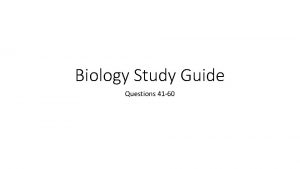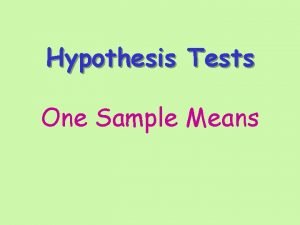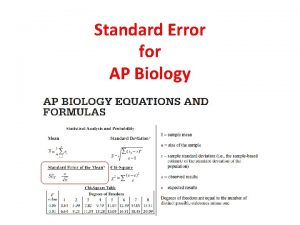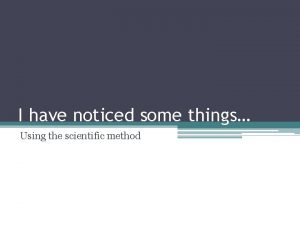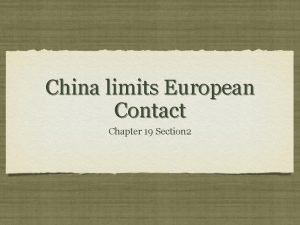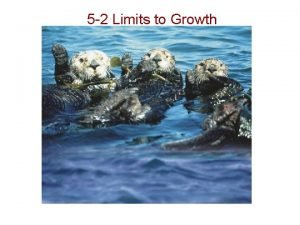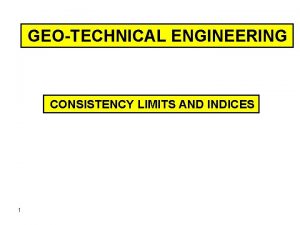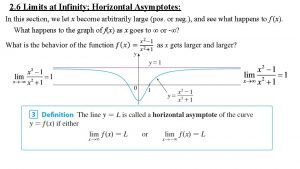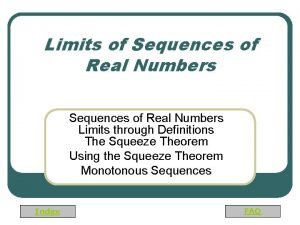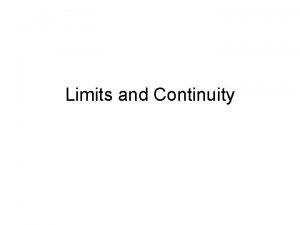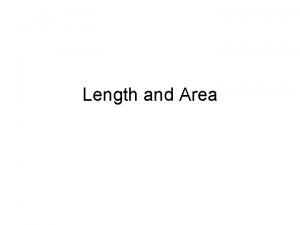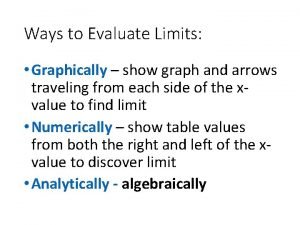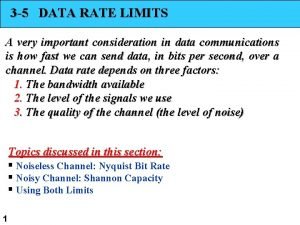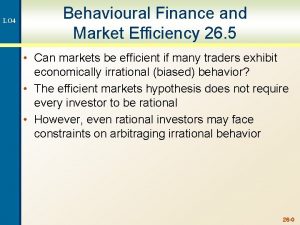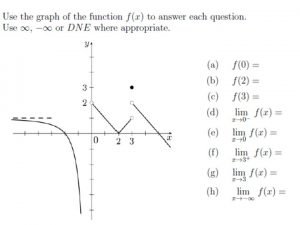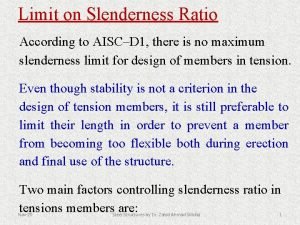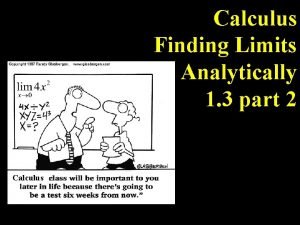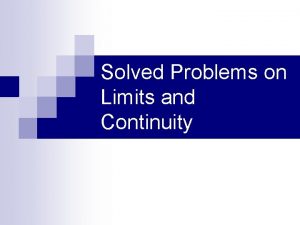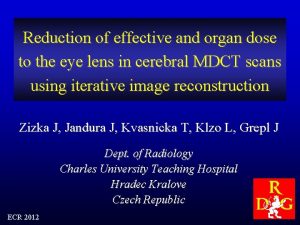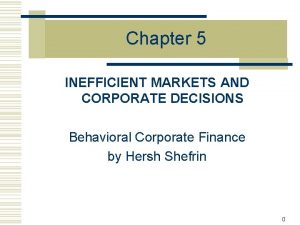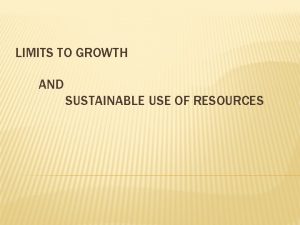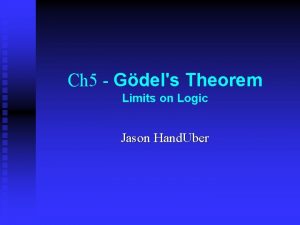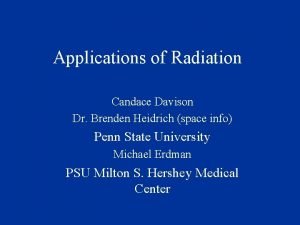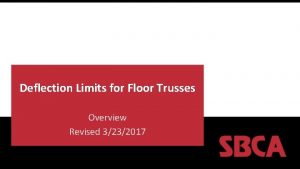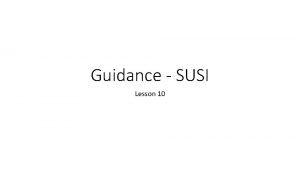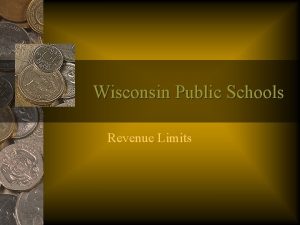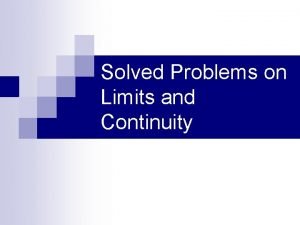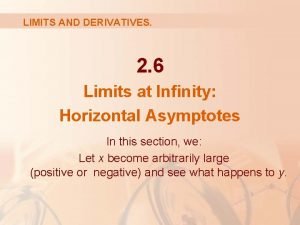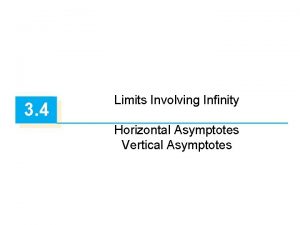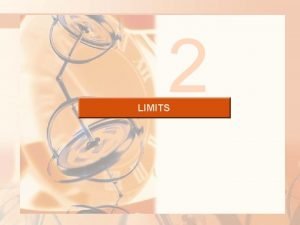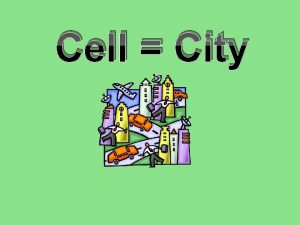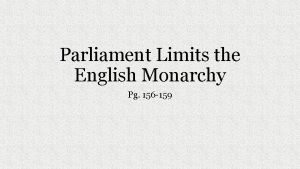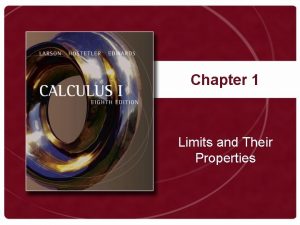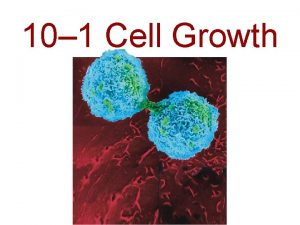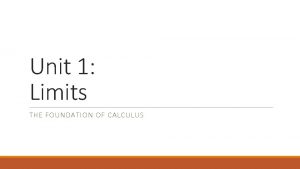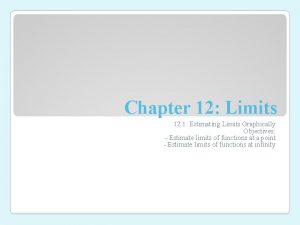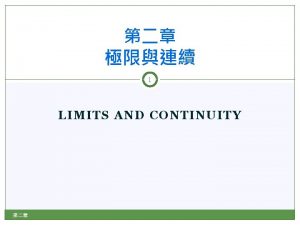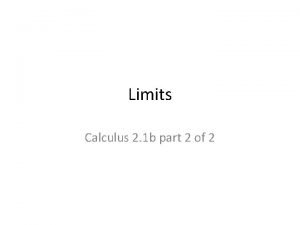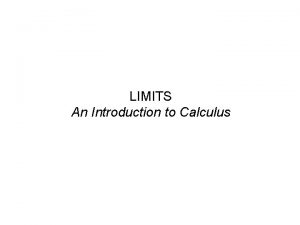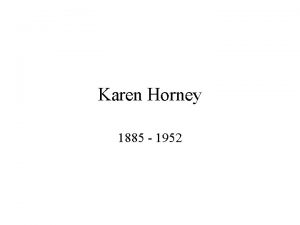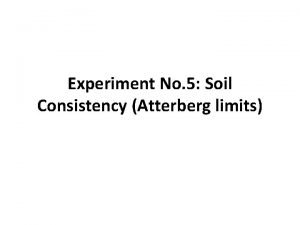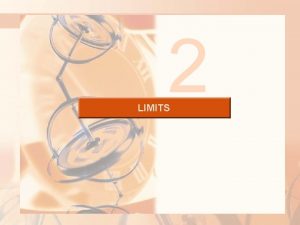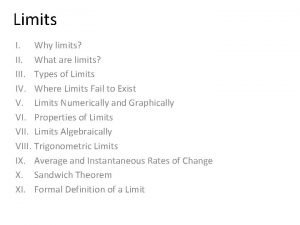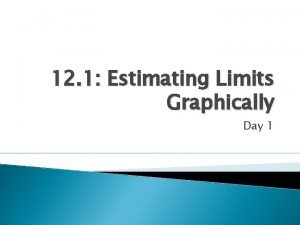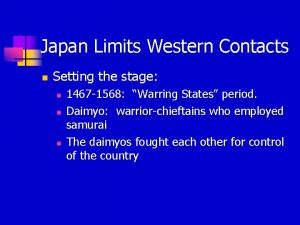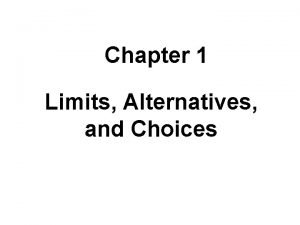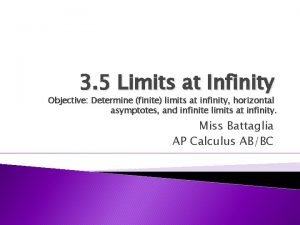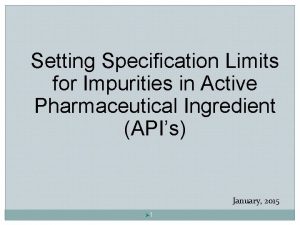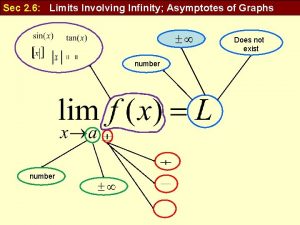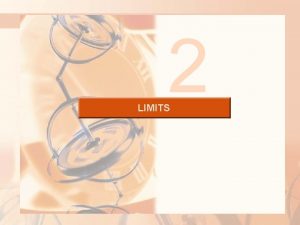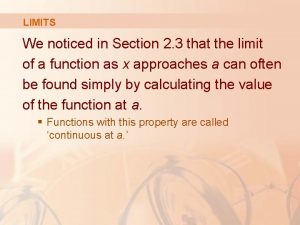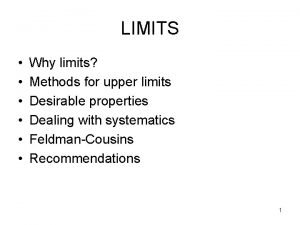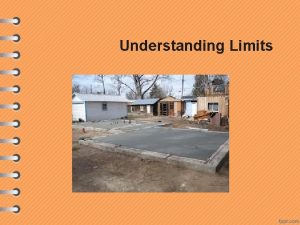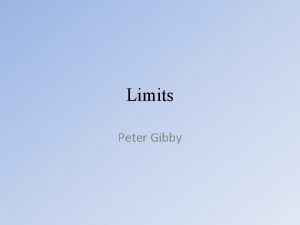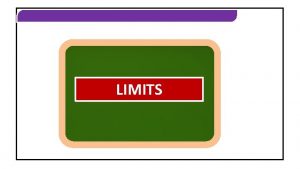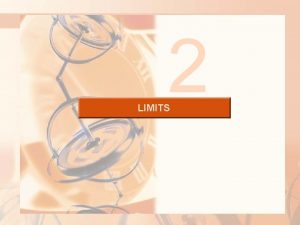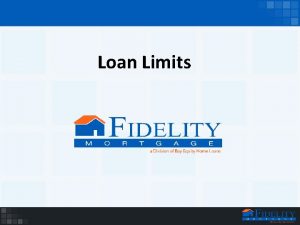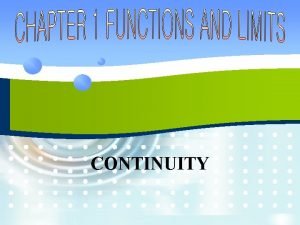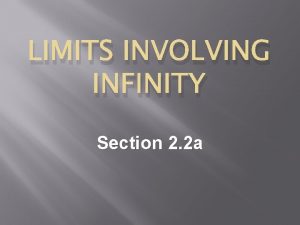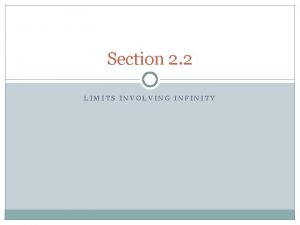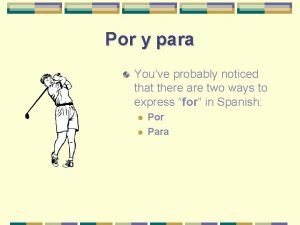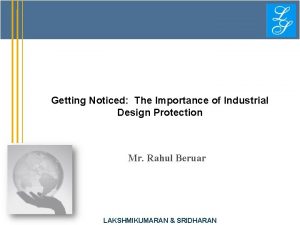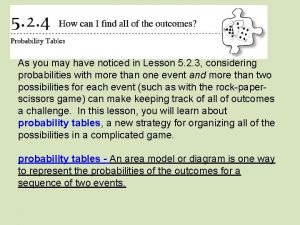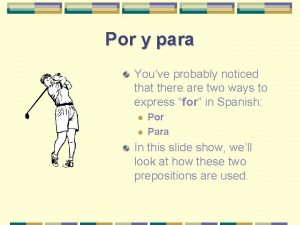2 LIMITS LIMITS We noticed in Section 2



























![CONTINUITY Example 4 Show that the function is continuous on the interval [-1, 1]. CONTINUITY Example 4 Show that the function is continuous on the interval [-1, 1].](https://slidetodoc.com/presentation_image/81ace207113b5be75398fc9d97d9cfd9/image-28.jpg)










































- Slides: 70

2 LIMITS

LIMITS We noticed in Section 2. 3 that the limit of a function as x approaches a can often be found simply by calculating the value of the function at a. § Functions with this property are called ‘continuous at a. ’

LIMITS 2. 5 Continuity In this section, we will: See that the mathematical definition of continuity corresponds closely with the meaning of the word continuity in everyday language.

CONTINUITY 1. Definition A function f is continuous at a number a if:

CONTINUITY Notice that Definition 1 implicitly requires three things if f is continuous at a: § f(a) is defined—that is, a is in the domain of f § exists. §.

CONTINUITY The definition states that f is continuous at a if f(x) approaches f(a) as x approaches a. § Thus, a continuous function f has the property that a small change in x produces only a small change in f(x). § In fact, the change in f(x) can be kept as small as we please by keeping the change in x sufficiently small.

CONTINUITY If f is defined near a—that is, f is defined on an open interval containing a, except perhaps at a—we say that f is discontinuous at a (or f has a discontinuity at a) if f is not continuous at a.

CONTINUITY Physical phenomena are usually continuous. § For instance, the displacement or velocity of a vehicle varies continuously with time, as does a person’s height.

CONTINUITY However, discontinuities do occur in such situations as electric currents. § See Example 6 in Section 2. 2, where the Heaviside function is discontinuous at 0 because does not exist.

CONTINUITY Geometrically, you can think of a function that is continuous at every number in an interval as a function whose graph has no break in it. § The graph can be drawn without removing your pen from the paper.

CONTINUITY Example 1 The figure shows the graph of a function f. At which numbers is f discontinuous? Why?

CONTINUITY Example 1 It looks as if there is a discontinuity when a = 1 because the graph has a break there. § The official reason that f is discontinuous at 1 is that f(1) is not defined.

CONTINUITY Example 1 The graph also has a break when a = 3. However, the reason for the discontinuity is different. § Here, f(3) is defined, but does not exist (because the left and right limits are different). § So, f is discontinuous at 3.

CONTINUITY Example 1 What about a = 5? § Here, f(5) is defined and exists (because the left and right limits are the same). § However, § So, f is discontinuous at 5.

CONTINUITY Now, let’s see how to detect discontinuities when a function is defined by a formula.

CONTINUITY Example 2 Where are each of the following functions discontinuous? a. b. c. d.

CONTINUITY Example 2 a Notice that f(2) is not defined. So, f is discontinuous at 2. § Later, we’ll see why f is continuous at all other numbers.

CONTINUITY Example 2 b Here, f(0) = 1 is defined. However, does not exist. § See Example 8 in Section 2. 2. So, f is discontinuous at 0.

CONTINUITY Example 2 c Here, f(2) = 1 is defined and exists. However, So, f is not continuous at 2.

CONTINUITY Example 2 d The greatest integer function has discontinuities at all the integers. This is because does not exist if n is an integer. § See Example 10 in Section 2. 3.

CONTINUITY The figure shows the graphs of the functions in Example 2. § In each case, the graph can’t be drawn without lifting the pen from the paper—because a hole or break or jump occurs in the graph.

CONTINUITY The kind of discontinuity illustrated in parts (a) and (c) is called removable. § We could remove the discontinuity by redefining f at just the single number 2. § The function is continuous.

CONTINUITY The discontinuity in part (b) is called an infinite discontinuity.

CONTINUITY The discontinuities in part (d) are called jump discontinuities. § The function ‘jumps’ from one value to another.

CONTINUITY 2. Definition A function f is continuous from the right at a number a if and f is continuous from the left at a if

CONTINUITY Example 3 At each integer n, the function is continuous from the right but discontinuous from the left because but

CONTINUITY 3. Definition A function f is continuous on an interval if it is continuous at every number in the interval. § If f is defined only on one side of an endpoint of the interval, we understand ‘continuous at the endpoint’ to mean ‘continuous from the right’ or ‘continuous from the left. ’
![CONTINUITY Example 4 Show that the function is continuous on the interval 1 1 CONTINUITY Example 4 Show that the function is continuous on the interval [-1, 1].](https://slidetodoc.com/presentation_image/81ace207113b5be75398fc9d97d9cfd9/image-28.jpg)
CONTINUITY Example 4 Show that the function is continuous on the interval [-1, 1].

CONTINUITY Example 4 If -1 < a < 1, then using the Limit Laws, we have:

CONTINUITY Example 4 Thus, by Definition 1, f is continuous at a if -1 < a < 1. § Similar calculations show that § So, f is continuous from the right at -1 and continuous from the left at 1. § Therefore, according to Definition 3, f is continuous on [-1, 1].

CONTINUITY Example 4 The graph of f is sketched in the figure. § It is the lower half of the circle

CONTINUITY Instead of always using Definitions 1, 2, and 3 to verify the continuity of a function, as we did in Example 4, it is often convenient to use the next theorem. § It shows how to build up complicated continuous functions from simple ones.

CONTINUITY 4. Theorem If f and g are continuous at a, and c is a constant, then the following functions are also continuous at a: 1. f + g 2. f - g 3. cf 4. fg 5.

CONTINUITY Each of the five parts of theorem follows from the corresponding Limit Law in Section 2. 3. § For instance, we give the proof of part 1.

CONTINUITY Proof Since f and g are continuous at a, we have: § Therefore, § This shows that f + g is continuous at a.

CONTINUITY It follows from Theorem 4 and Definition 3 that, if f and g are continuous on an interval, then so are the functions f + g, f - g, cf, fg, and (if g is never 0) f/g.

CONTINUITY The following theorem was stated in Section 2. 3 as the Direct Substitution Property.

CONTINUITY 5. Theorem a. Any polynomial is continuous everywhere —that is, it is continuous on b. Any rational function is continuous wherever it is defined—that is, it is continuous on its domain.

CONTINUITY As an illustration of Theorem 5, observe that the volume of a sphere varies continuously with its radius. § This is because the formula shows that V is a polynomial function of r.

CONTINUITY Similarly, if a ball is thrown vertically into the air with a velocity of 50 ft/s, then the height of the ball in feet t seconds later is given by the formula h = 50 t - 16 t 2. § Again, this is a polynomial function. § So, the height is a continuous function of the elapsed time.

CONTINUITY Knowledge of which functions are continuous enables us to evaluate some limits very quickly—as the following example shows. § Compare it with Example 2(b) in Section 2. 3.

CONTINUITY Example 5 Find § The function is rational. § So, by Theorem 5, it is continuous on its domain, which is: § Therefore,

CONTINUITY It turns out that most of the familiar functions are continuous at every number in their domains. § For instance, Limit Law 10 is exactly the statement that root functions are continuous.

CONTINUITY From the appearance of the graphs of the sine and cosine functions, we would certainly guess that they are continuous.

CONTINUITY 6. Definition We know from the definitions of and that the coordinates of the point P in the figure are. § As and so § Thus, , we see that P approaches the point (1, 0) and.

CONTINUITY Since and , the equations in Definition 6 assert that the cosine and sine functions are continuous at 0. § The addition formulas for cosine and sine can then be used to deduce that these functions are continuous everywhere.

CONTINUITY It follows from part 5 of Theorem 4 that is continuous except where cos x = 0.

CONTINUITY This happens when x is an odd integer multiple of. So, y = tan x has infinite discontinuities when and so on.

CONTINUITY 7. Theorem The following types of functions are continuous at every number in their domains: § § Polynomials Rational functions Root functions Trigonometric functions

CONTINUITY Example 7 Evaluate § Theorem 7 gives us that y = sin x is continuous. § The function in the denominator, y = 2 + cos x, is the sum of two continuous functions and is therefore continuous. § Notice that this function is never 0 because for all x and so 2 + cos x > 0 everywhere.

CONTINUITY Example 7 § Thus, the ratio is continuous everywhere. § Hence, by the definition of a continuous function,

CONTINUITY Another way of combining continuous functions f and g to get a new continuous function is to form the composite function § This fact is a consequence of the following theorem.

CONTINUITY If f is continuous at b and then 8. Theorem , In other words, § Intuitively, Theorem 8 is reasonable. § If x is close to a, then g(x) is close to b; and, since f is continuous at b, if g(x) is close to b, then f(g(x)) is close to f(b).

CONTINUITY Let’s now apply Theorem 8 in the special case where , with n being a positive integer. § Then, and § If we put these expressions into Theorem 8, we get: § So, Limit Law 11 has now been proved. (We assume that the roots exist. )

CONTINUITY 9. Theorem If g is continuous at a and f is continuous at g(a), then the composite function given by is continuous at a. § This theorem is often expressed informally by saying “a continuous function of a continuous function is a continuous function. ”

CONTINUITY Example 8 Where are these functions continuous? a. b.

CONTINUITY Example 8 a We have h(x) = f(g(x)), where and § Now, g is continuous on since it is a polynomial, and f is also continuous everywhere. § Thus, is continuous on by Theorem 9.

CONTINUITY Example 8 b Notice that F can be broken up as the composition of four continuous functions where:

CONTINUITY Example 8 b We know that each of these functions is continuous on its domain (by Theorems 5 and 7). § So, by Theorem 9, F is continuous on its domain, which is:

CONTINUITY An important property of continuous functions is expressed by the following theorem. § Its proof is found in more advanced books on calculus.

INTERMEDIATE VALUE THEOREM 10. Theorem Suppose that f is continuous on the closed interval [a, b] and let N be any number between f(a) and f(b), where. Then, there exists a number c in (a, b) such that f(c) = N.

INTERMEDIATE VALUE THEOREM The theorem states that a continuous function takes on every intermediate value between the function values f(a) and f(b).

INTERMEDIATE VALUE THEOREM The theorem is illustrated by the figure. § Note that the value N can be taken on once [as in (a)] or more than once [as in (b)].

INTERMEDIATE VALUE THEOREM If we think of a continuous function as a function whose graph has no hole or break, then it is easy to believe that theorem is true.

INTERMEDIATE VALUE THEOREM In geometric terms, it states that, if any horizontal line y = N is given between y = f(a) and f(b) as in the figure, then the graph of f can’t jump over the line. § It must intersect y = N somewhere.

INTERMEDIATE VALUE THEOREM It is important that the function in theorem be continuous. § The theorem is not true in general for discontinuous functions.

INTERMEDIATE VALUE THEOREM One use of theorem is in locating roots of equations—as in the following example.

INTERMEDIATE VALUE THEOREM Example 9 Show that there is a root of the equation between 1 and 2. § Let. § We are looking for a solution of the given equation— that is, a number c between 1 and 2 such that f(c) = 0. § Therefore, we take a = 1, b = 2, and N = 0 in theorem. § We have and

INTERMEDIATE VALUE THEOREM Example 9 § Thus, f(1) < 0 < f(2)—that is, N = 0 is a number between f(1) and f(2). § Now, f is continuous since it is a polynomial. § So, theorem states that there is a number c between 1 and 2 such that f(c) = 0. § In other words, the equation has at least one root in the interval (1, 2).

INTERMEDIATE VALUE THEOREM Example 9 § In fact, we can locate a root more precisely by using theorem again. § Since a root must lie between 1. 2 and 1. 3. § A calculator gives, by trial and error, § So, a root lies in the interval (1. 22, 1. 23).
 Limits involving infinity
Limits involving infinity Real limits vs. apparent limits
Real limits vs. apparent limits What inclusions have you noticed
What inclusions have you noticed Darwin noticed that many organisms seemed well suited to
Darwin noticed that many organisms seemed well suited to A whale watching company noticed that many customers
A whale watching company noticed that many customers Standard error of statistics
Standard error of statistics Sadlier level e unit 12
Sadlier level e unit 12 Things i have noticed
Things i have noticed Chapter 19 section 2 china limits european contacts
Chapter 19 section 2 china limits european contacts Parliament limits the english monarchy chapter 5 section 5
Parliament limits the english monarchy chapter 5 section 5 Chapter 19 section 2 china limits european contacts
Chapter 19 section 2 china limits european contacts 5-2 limits to growth
5-2 limits to growth Parliament limits the english monarchy chapter 5 section 5
Parliament limits the english monarchy chapter 5 section 5 Full section vs half section
Full section vs half section Removed view
Removed view Section 2 describing energy (continued)
Section 2 describing energy (continued) Section quick check chapter 10 section 1 meiosis answer key
Section quick check chapter 10 section 1 meiosis answer key Revolved sections
Revolved sections Consistency limits in geotechnical engineering
Consistency limits in geotechnical engineering Limits at infinity (horizontal asymptotes)
Limits at infinity (horizontal asymptotes) Confined space gas limits
Confined space gas limits Limits of sequences
Limits of sequences Limits and continuity
Limits and continuity Limit of accuracy
Limit of accuracy Radiation dose limits
Radiation dose limits Ways to evaluate limits
Ways to evaluate limits Data rate limits
Data rate limits Limits to arbitrage
Limits to arbitrage Ab calculus finding limits algebraically homework
Ab calculus finding limits algebraically homework Pnenumbra
Pnenumbra Limiting slenderness ratio
Limiting slenderness ratio Finding limits by rationalizing
Finding limits by rationalizing Imperfect mobility
Imperfect mobility Limits and continuity problems with solutions
Limits and continuity problems with solutions Radiation dose limits chart
Radiation dose limits chart Limits to arbitrage
Limits to arbitrage Limits to growth
Limits to growth Limits of logic
Limits of logic Radiation dose limits
Radiation dose limits Roof truss deflection limits
Roof truss deflection limits Mpdu orientation seminar registration
Mpdu orientation seminar registration Susi grant limits
Susi grant limits 40h11 tolerance
40h11 tolerance Wi school district revenue limits historical
Wi school district revenue limits historical Limit and continuity solved problems
Limit and continuity solved problems Horizontal asymptote limits
Horizontal asymptote limits Limits at infinity (horizontal asymptotes)
Limits at infinity (horizontal asymptotes) How to tell if the limit exists
How to tell if the limit exists Attribute control charts
Attribute control charts Cell city analogy
Cell city analogy Parliament limits the english monarchy
Parliament limits the english monarchy Limits and their properties
Limits and their properties Limits to cell growth
Limits to cell growth Limit to infinity rule
Limit to infinity rule 12-1 estimating limits graphically
12-1 estimating limits graphically Prof emc
Prof emc Limits
Limits Confined space gas limits
Confined space gas limits Calculus 2 limits
Calculus 2 limits Limits the impact of vehicle balance
Limits the impact of vehicle balance Calculus
Calculus Neurotic needs
Neurotic needs Liquid limit flow curve
Liquid limit flow curve Intuitive notion of limits
Intuitive notion of limits What is lim
What is lim Finding limits graphically and numerically worksheet
Finding limits graphically and numerically worksheet Japan limits western contacts
Japan limits western contacts Society's economizing problem involves
Society's economizing problem involves Limits at infinity definition
Limits at infinity definition Impurity specification limits
Impurity specification limits Sec asymptotes
Sec asymptotes



